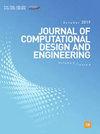基于蚁群优化的多阈值遥感图像分割
IF 6.1
2区 工程技术
Q1 COMPUTER SCIENCE, INTERDISCIPLINARY APPLICATIONS
引用次数: 0
摘要
遥感影像可以为城市地表形态和地理状况提供直接、准确的反馈。它们可以作为当前地理空间信息系统收集数据的辅助手段,在城市公共安全中也得到了广泛的应用。因此,有必要对遥感图像进行研究。因此,本文采用多阈值图像分割方法对遥感图像进行分割进行研究。本文首先将salp觅食行为引入到连续蚁群优化算法(ACOR)中,构建了一个基于salp觅食的连续蚁群优化算法(SSACO)。采用海藻觅食行为增强了原算法的收敛性和避免局部最优的能力。为了说明这一关键优势,SSACO首先使用IEEE CEC2017中的30个基准测试函数与14种基本算法进行了比较。然后,将SSACO算法与其他14种算法进行比较。从多个角度对实验结果进行了检验,结果令人信服地证明了SSACO的主要卖点。通过对12幅遥感影像进行SSACO分割技术与几种同类分割方法的分割对比研究,验证了SSACO在遥感影像分割中的优势。峰值信噪比、结构相似度指数和特征相似度指数对分割结果的评价表明了基于ssac的分割方法的优越性。SSACO是一个优秀的优化者,因为它寻求成为在城市公共安全中使用遥感图像算法的指南和参考点。本文章由计算机程序翻译,如有差异,请以英文原文为准。
Multi-threshold remote sensing image segmentation with improved ant colony optimizer with salp foraging
Abstract Remote sensing images can provide direct and accurate feedback on urban surface morphology and geographic conditions. They can be used as an auxiliary means to collect data for current geospatial information systems, which are also widely used in city public safety. Therefore, it is necessary to research remote-sensing images. Therefore, we adopt the multi-threshold image segmentation method in this paper to segment the remote-sensing images for research. We first introduce salp foraging behavior into the continuous ant colony optimization algorithm (ACOR) and construct a novel ACOR version based on salp foraging (SSACO). The original algorithm's convergence and ability to avoid hitting local optima are enhanced by salp foraging behavior. In order to illustrate this key benefit, SSACO is first put up against 14 fundamental algorithms using 30 benchmark test functions in IEEE CEC2017. Then, SSACO is compared against 14 other algorithms. The experimental results are examined from various angles, and the findings convincingly demonstrate the main selling point of SSACO. We performed segmentation comparison studies based on 12 remote sensing images between SSACO segmentation techniques and several peer segmentation approaches to demonstrate the benefits of SSACO in remote sensing image segmentation. Peak signal-to-noise ratio, structural similarity index, and feature similarity index evaluation of the segmentation results demonstrated the benefits of the SSACO-based segmentation approach. SSACO is an excellent optimizer since it seeks to serve as a guide and a point of reference for using remote sensing image algorithms in urban public safety.
求助全文
通过发布文献求助,成功后即可免费获取论文全文。
去求助
来源期刊

Journal of Computational Design and Engineering
Computer Science-Human-Computer Interaction
CiteScore
7.70
自引率
20.40%
发文量
125
期刊介绍:
Journal of Computational Design and Engineering is an international journal that aims to provide academia and industry with a venue for rapid publication of research papers reporting innovative computational methods and applications to achieve a major breakthrough, practical improvements, and bold new research directions within a wide range of design and engineering:
• Theory and its progress in computational advancement for design and engineering
• Development of computational framework to support large scale design and engineering
• Interaction issues among human, designed artifacts, and systems
• Knowledge-intensive technologies for intelligent and sustainable systems
• Emerging technology and convergence of technology fields presented with convincing design examples
• Educational issues for academia, practitioners, and future generation
• Proposal on new research directions as well as survey and retrospectives on mature field.
 求助内容:
求助内容: 应助结果提醒方式:
应助结果提醒方式:


